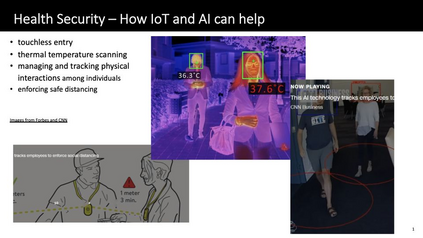The Internet of Things (IoT) and edge computing applications aim to support a variety of societal needs, including the global pandemic situation that the entire world is currently experiencing and responses to natural disasters. The need for real-time interactive applications such as immersive video conferencing, augmented/virtual reality, and autonomous vehicles, in education, healthcare, disaster recovery and other domains, has never been higher. At the same time, there have been recent technological breakthroughs in highly relevant fields such as artificial intelligence (AI)/machine learning (ML), advanced communication systems (5G and beyond), privacy-preserving computations, and hardware accelerators. 5G mobile communication networks increase communication capacity, reduce transmission latency and error, and save energy -- capabilities that are essential for new applications. The envisioned future 6G technology will integrate many more technologies, including for example visible light communication, to support groundbreaking applications, such as holographic communications and high precision manufacturing. Many of these applications require computations and analytics close to application end-points: that is, at the edge of the network, rather than in a centralized cloud. AI techniques applied at the edge have tremendous potential both to power new applications and to need more efficient operation of edge infrastructure. However, it is critical to understand where to deploy AI systems within complex ecosystems consisting of advanced applications and the specific real-time requirements towards AI systems.
翻译:互联网(IOT)和边际计算应用程序旨在支持各种社会需求,包括全世界目前正在经历的全球大流行病状况和应对自然灾害的对策。在教育、保健、灾后恢复和其他领域,需要实时互动应用程序,如即时电视会议、增强/虚拟现实和自主车辆,教育、保健、灾后恢复和其他领域从未如此高超。与此同时,在高度相关的领域,如人工智能/机器学习(AI)/机器学习(ML)、先进的通信系统(5G及以后)、隐私保存计算和硬件加速器等,最近出现了技术突破。5G移动通信网络提高了通信能力,减少了传输延迟和错误,并节省了对新应用至关重要的能源。设想中的6G技术将整合更多的技术,包括可见光通信,以支持光通信和高精度制造等破碎的应用。许多这类应用都需要计算和分析接近应用终端点:这是在网络的边缘,而不是在中央云层应用中。 AI技术在现实的前沿应用中具有巨大的潜力,在现实的前沿应用中,在复杂的生态系统中,在现实的前沿应用中具有巨大的潜力。








